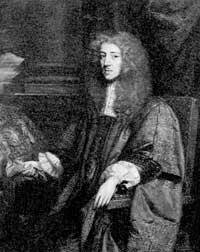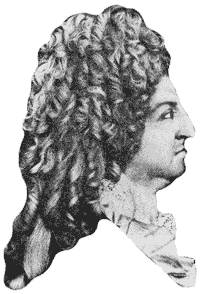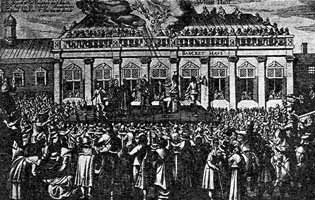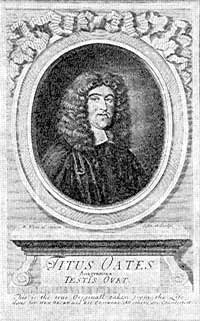|
Loading
|
|
|
The Soldier's Fortune
Historical context — the Restoration of Charles II
- LADY DUNCE:
- "There lies the greatest comfort of my uneasy life; he is one of those fools, forsooth, that are led by the nose by knaves to rail against the King and the government, and is mightily fond of being thought of a party."
 In
an age when the King still ruled as well as reigned there were no political
parties in the modern sense because politicians were not organised into coherent
groups able to conduct responsible government. Ministers were in fact as well as
name "King's Servants". Parliament was split into a series of "connections",
groups linked variously by a common local background, e.g. East Anglia, West
Country, by family ties, by obligation to a great local landowner, etc., etc.
Nevertheless both ordinarily and most especially in times of national crisis
(such as the Popish plot and the reaction which followed) men felt themselves to
be acting on principle, although this by no means pre-determined their conduct
on particular issues. Originally "Tory" (Irish robber) and "Whig" (Scottish
outlaw) were terms of abuse which became popular in the years of extreme
reaction following the Popish plot. Broadly speaking the "Tory" "party" stood
for the rights of the Church (Established Anglican) and King (Divine Right as
often as not) and the "Whig" "party", largely of a Presbyterian background, for
the power of Parliament, the constitutional rights of the subject and the
supremacy of the law.
In
an age when the King still ruled as well as reigned there were no political
parties in the modern sense because politicians were not organised into coherent
groups able to conduct responsible government. Ministers were in fact as well as
name "King's Servants". Parliament was split into a series of "connections",
groups linked variously by a common local background, e.g. East Anglia, West
Country, by family ties, by obligation to a great local landowner, etc., etc.
Nevertheless both ordinarily and most especially in times of national crisis
(such as the Popish plot and the reaction which followed) men felt themselves to
be acting on principle, although this by no means pre-determined their conduct
on particular issues. Originally "Tory" (Irish robber) and "Whig" (Scottish
outlaw) were terms of abuse which became popular in the years of extreme
reaction following the Popish plot. Broadly speaking the "Tory" "party" stood
for the rights of the Church (Established Anglican) and King (Divine Right as
often as not) and the "Whig" "party", largely of a Presbyterian background, for
the power of Parliament, the constitutional rights of the subject and the
supremacy of the law.
- FOUR BIN:
- "I told him . . . that I had had the honour of serving the great monarch of France in his wars in Flanders, where I contracted great familiarity and intimacy with a gallant officer of the English troops in that service, one Captain Beaugard".
 In
1672 England went to war against the Dutch for the third time since the
execution of Charles I. The wars of 1652-4 and 1665-7 were caused by commercial
and maritime rivalry. The two countries were still competitors in 1672 but the
situation was complicated by England Treaty obligations to France and the war
was fought jointly with Louis XIV and principally to further French territorial
ambitions. English troops were sent to Flanders and, although England withdrew
from the war in 1674, continued there in Louis' service under the command of the
Duke of Monmouth, the natural son of Charles II. They were not recalled until
1677 when Charles II underwent a change of heart, married his niece Mary to
Louis' arch-enemy, William of Orange, and agreed with the Dutch that France
should be forced to a settlement. In May 1678, peace was thought to be imminent
and it was announced that the English troops were to be disbanded, but then
negotiations were delayed and English reinforcements sent to Flanders. In August
France and Holland finally came to terms and the English Army was disbanded.
In
1672 England went to war against the Dutch for the third time since the
execution of Charles I. The wars of 1652-4 and 1665-7 were caused by commercial
and maritime rivalry. The two countries were still competitors in 1672 but the
situation was complicated by England Treaty obligations to France and the war
was fought jointly with Louis XIV and principally to further French territorial
ambitions. English troops were sent to Flanders and, although England withdrew
from the war in 1674, continued there in Louis' service under the command of the
Duke of Monmouth, the natural son of Charles II. They were not recalled until
1677 when Charles II underwent a change of heart, married his niece Mary to
Louis' arch-enemy, William of Orange, and agreed with the Dutch that France
should be forced to a settlement. In May 1678, peace was thought to be imminent
and it was announced that the English troops were to be disbanded, but then
negotiations were delayed and English reinforcements sent to Flanders. In August
France and Holland finally came to terms and the English Army was disbanded.
In The Soldier's Fortune, Courtine says:
"A curse on the fates! Of all strumpets, fortune's the basest. `Twas fortune made me a soldier, a rogue in red, the grievance of the nation; fortune made the peace just when we were on the brink of a war; then fortune disbanded us, and lost us two months' pay.
(Act II, Sc. l.)
- SIR DAVY:
- "Sir, I am a free-born subject of England and there are laws, look you, there are laws. . . "
 The
right of a `free man" to freedom from imprisonment "unless by the lawful
judgment of his peers, or by the law of the land" went back to Magna Carta
(1215). The writ of Habeas Corpus was the means whereby a prisoner secured a
trial in case of arbitrary arrest since its issue obliged his gaolers to account
for his detention in a Court of Law. In the years before the Civil War (see
Petition of Right on the same point) and again under Charles II the Crown found
means to evade its use in the case of certain political prisoners. There were
"great delayes" and one prisoner was deliberately move) from the Tower of London
to an island where the writ did not run. The "Whig" Parliament of 1679 elected
at the height of national reaction to the Popish plot and the threat of
arbitrary government, secured the Royal Assent to "The Habeas Corpus Act" which
required that, on issue of the writ, gaolers should, within three days, bring
"the Body of the Partie . . . committed" before a Court and "certifie the true
causes of his . . . Imprisonment".
The
right of a `free man" to freedom from imprisonment "unless by the lawful
judgment of his peers, or by the law of the land" went back to Magna Carta
(1215). The writ of Habeas Corpus was the means whereby a prisoner secured a
trial in case of arbitrary arrest since its issue obliged his gaolers to account
for his detention in a Court of Law. In the years before the Civil War (see
Petition of Right on the same point) and again under Charles II the Crown found
means to evade its use in the case of certain political prisoners. There were
"great delayes" and one prisoner was deliberately move) from the Tower of London
to an island where the writ did not run. The "Whig" Parliament of 1679 elected
at the height of national reaction to the Popish plot and the threat of
arbitrary government, secured the Royal Assent to "The Habeas Corpus Act" which
required that, on issue of the writ, gaolers should, within three days, bring
"the Body of the Partie . . . committed" before a Court and "certifie the true
causes of his . . . Imprisonment".
- BLOODY BONES:
- "In peaceable times !a man may eat and drink comfortably upon't; a private murder so done handsomely is worth money; but now that the nation's unsettled, there are so many general undertakers, that 'tis grown almost a monopoly: you may have a man murdered almost for little or nothing, and nobody e'er knows who did it neither".
 The
"Popish plot" followed more than a decade of intrigue and secret understandings
between Charles II and Louis XIV of France to reestablish Roman Catholicism in
England by force if necessary. The "Plot" was the invention of Titus Oates, an
Anglican clergyman of dubious connections, and his friend, Dr. Israel Tonge,
also a cleric and a passionate anti-Catholic. Oates claimed to have discovered a
Roman Catholic plot to assassinate the King, massacre Protestants and set James,
Duke of York, the King's Romish brother, on the throne to rule with the help of
a Jesuit clique. The plot seemed the more credible to a credulous public when
Sir Edmund Berry Godfrey, the London magistrate who had taken the depositions
from Oates and Tonge, was found dead on Primrose Hill with a sword through his
body. He was immediately assumed to have been murdered to close his mouth,
Parliament resolved that "there hath been and still is a damnable and hellish
Plot, contrived and carried on by Popish Recusants, for the assassinating and
murdering the King and rooting out and destroying the Protestant religion" and
national panic ensued. Arrests and executions followed and the new "Whig"
Parliament of 1679, elected at the height of the reaction, tried, among other
things, to pass a bill to exclude the Duke of York from the succession in favour
of the next Protestant heir. The next Protestant heir, in the legitimate line,
was Mary, wife of William of Orange.
The
"Popish plot" followed more than a decade of intrigue and secret understandings
between Charles II and Louis XIV of France to reestablish Roman Catholicism in
England by force if necessary. The "Plot" was the invention of Titus Oates, an
Anglican clergyman of dubious connections, and his friend, Dr. Israel Tonge,
also a cleric and a passionate anti-Catholic. Oates claimed to have discovered a
Roman Catholic plot to assassinate the King, massacre Protestants and set James,
Duke of York, the King's Romish brother, on the throne to rule with the help of
a Jesuit clique. The plot seemed the more credible to a credulous public when
Sir Edmund Berry Godfrey, the London magistrate who had taken the depositions
from Oates and Tonge, was found dead on Primrose Hill with a sword through his
body. He was immediately assumed to have been murdered to close his mouth,
Parliament resolved that "there hath been and still is a damnable and hellish
Plot, contrived and carried on by Popish Recusants, for the assassinating and
murdering the King and rooting out and destroying the Protestant religion" and
national panic ensued. Arrests and executions followed and the new "Whig"
Parliament of 1679, elected at the height of the reaction, tried, among other
things, to pass a bill to exclude the Duke of York from the succession in favour
of the next Protestant heir. The next Protestant heir, in the legitimate line,
was Mary, wife of William of Orange.
Time line
| 1649 | Charles I executed. |
| 1650 | Montrose hanged. |
| Cromwell returns from subjugation of Ireland. | |
| 1652 | First War against the Dutch. |
| Thomas Otway born. | |
| 1653 | Cromwell made Lord Protector. |
| Jews readmitted to England. | |
| 1658 | Death of Cromwell. |
| Elizabeth Barry born. | |
| 1660 | The Restoration of Charles II and execution of the regicides. |
| The Royal Society founded. | |
| 1663 | John Milton completed "Paradise Lost". |
| 1664 | "Tartuffe" produced privately by Molière. |
| 1665 | The Second Dutch War. |
| Great Plague swept London. | |
| 1666 | Great Fire destroys much of the City. |
| 1667 | Treaty of Breda ended Dutch War and England kept New York. |
| Fall of Clarendon, Chief Minister and James II's father-in-law. | |
| The Cabal (Clifford, Arlington, Buckingham, Anthony Ashley Cooper and Lauderdale) constituted Charles II's intimate ministers. | |
| 1670 | The Treaty, and Secret Treaty, of Dover made with Louis XIV-two differing plans to place England and Europe under the influence and 'power of the |
| French Catholic monarchy. | |
| Birth of William Congreve. | |
| 1672 | The Third Dutch War. |
| Revolution in Holland, Republic overthrown. | |
| 1673 | Death of Molière. |
| 1677 | Mary, daughter of James II, married William of Orange. |
| Racine's Phèdre first produced. | |
| 1678 | Otway and his regiment set out for Flanders. |
| Titus Oates' Popish Plot creates national crisis. | |
| 1679 | First Whig Parliament. Habeas Corpus Act. |
| 1680 | The Soldier's Fortune is produced at the Duke's Theatre. |
| 1682 | Venice Preserv'd is produced at the Duke's Theatre. |
| Shaftesbury, the Whig leader, flees the country. | |
| 1683 | Thomas Otway dies. |
| 1685 | Charles II dies. |